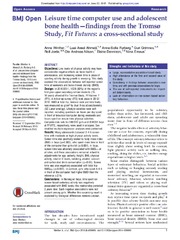| dc.description.abstract | <p>Objectives: Low levels of physical activity may have
considerable negative effects on bone health in
adolescence, and increasing screen time in place of
sporting activity during growth is worrying. This study
explored the associations between self-reported screen
time at weekends and bone mineral density (BMD).
<p>Design: In 2010/2011, 1038 (93%) of the region’s
first-year upper-secondary school students (15–
18 years) attended the Tromsø Study, Fit Futures 1
(FF1). A follow-up survey (FF2) took place in 2012/
2013. BMD at total hip, femoral neck and total body
was measured as g/cm² by dual X-ray absorptiometry
(GE Lunar prodigy). Lifestyle variables were selfreported,
including questions on hours per day spent
in front of television/computer during weekends and
hours spent on leisure time physical activities.
Complete data sets for 388/312 girls and 359/231 boys
at FF1/FF2, respectively, were used in analyses. Sex
stratified multiple regression analyses were performed.
<p>Results: Many adolescents balanced 2–4 h screen
time with moderate or high physical activity levels.
Screen time was positively related to body mass index
(BMI) in boys ( p=0.002), who spent more time in front
of the computer than girls did ( p<0.001). In boys,
screen time was adversely associated with BMDFF1 at
all sites, and these associations remained robust to
adjustments for age, puberty, height, BMI, physical
activity, vitamin D levels, smoking, alcohol, calcium
and carbonated drink consumption ( p<0.05). Screen
time was also negatively associated with total hip
BMDFF2 ( p=0.031). In contrast, girls who spent 4–6 h
in front of the computer had higher BMD than the
reference (<2 h).
<p>Conclusions: In Norwegian boys, time spent on
screen-based sedentary activity was negatively
associated with BMD levels; this relationship persisted
2 years later. Such negative associations were not
present among girls. Whether this surprising result is
explained by biological differences remains unclear. | en_US |


 English
English norsk
norsk